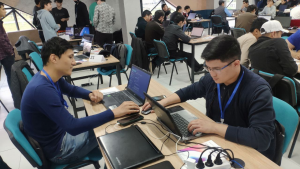Rules of Engagement: Understanding Hackathon Guidelines
Rules of Engagement: Understanding Hackathon Guidelines
Blog Article
Hackathons are entertaining events that gather creative minds and technical skills to fix problems and develop innovative solutions in just a limited timeframe, usually 24 to 2 days. While the atmosphere is frequently fun and collaborative, a number of rules and guidelines that participants is required to follow to ensure an easy, fair, and productive experience for anyone involved. Understanding these rules is essential for a successful Sign up. Here’s a dysfunction of the common things that govern hackathons.
1. Eligibility and Team Formation
Participant Eligibility: Most hackathons are ready to accept students, professionals, or specific communities, with regards to the organizer's focus. Ensure you satisfy the eligibility criteria before registering.
Team Size: Hackathons routinely have rules regarding team size, often allowing teams of 2 to 5 participants. Check the specific rules of the hackathon you're attending for virtually any restrictions or recommendations.
Team Formation: Some hackathons let you come with a pre-formed team, although some encourage participants to make teams in the event. Be available to collaborating with new people to enhance your experience.
2. Project Scope and Requirements
Original Work: All projects submitted has to be original work created throughout the hackathon. Participants are generally not allowed to use pre-built software or tools unless explicitly permitted with the rules.
Project Scope: Hackathons frequently have a theme or specific challenges to address. Make sure assembling your project aligns with all the event's focus, be it developing a solution for social good, addressing technical challenges, or creating a progressive app.
Submission Requirements: Each hackathon could have specific submission guidelines detailing what must be submitted (e.g., code repositories, project presentations, demos) and exactly how. Ensure you read and understand these requirements ahead of the deadline.
3. Intellectual Property and Ownership
Ownership of Work: Participants typically retain ownership of the projects, yet it's essential to clarify this while using organizers. Some hackathons may require that the projects be open-sourced or that participants grant rights for promotional use.
Respect for Others' Work: Plagiarism or even the use of copyrighted material without permission is strictly prohibited. Always credit original sources or authors when working with third-party libraries, APIs, and other resources.
4. Code of Conduct
Respectful Behavior: All participants are expected to behave professionally and respectfully towards others. Harassment, discrimination, or any form of inappropriate conduct will not be tolerated.
Collaboration Over Competition: While hackathons are competitive, the main focus must be on collaboration and learning. Encourage and support fellow participants, and be available to sharing knowledge and skills.
Mentorship Interaction: Many hackathons offer mentors who are able to provide guidance. Treat mentors with respect, and employ their feedback to increase your project.
5. Time Management and Structure
Time Limit: Hackathons are time-sensitive events. Be mindful of the time allotted for the competition, and plan your project development accordingly to ensure you have the time for testing and presentation.
Presentation Timing: Pay attention to some time allocated for project presentations. Stick for the allotted time, as judges could have many projects to examine.
6. Judging Criteria
Evaluation Process: Familiarize yourself using the judging criteria beforehand. Hackathon projects are usually judged based on innovation, technical complexity, usability, impact, and presentation.
Feedback Opportunity: After the judging process, many hackathons provide an opportunity for participants for feedback from judges. Use this time constructively to find out and improve for future events.
7. Post-Hackathon Follow-Up
Project Sharing: Many hackathons encourage participants to share with you their projects publicly following the event. This can include posting on social networking, GitHub, or the event's website.
Networking: Utilize the opportunity to connect with judges, mentors, and fellow participants as soon as the event. Building relationships can cause future collaboration, mentorship, or occupations.
Participating inside a hackathon is an exhilarating experience that can bring about innovation, skill development, and networking opportunities. However, understanding and staying with the laws and regulations is essential for a successful and rewarding experience. By following these common rules, participants can ensure they contribute positively to the hackathon community, grow their learning experience, and foster a spirit of collaboration and creativity. Whether you’re a first-time participant or even a seasoned hacker, keeping these rules in your mind will help you make the most of your hackathon journey.